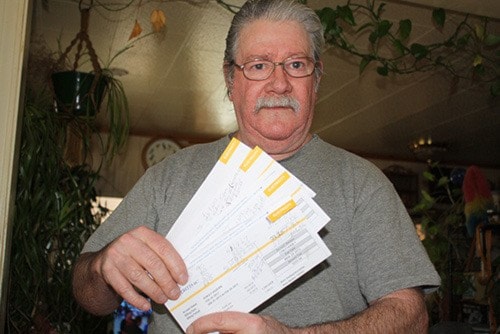Robbie Killborn of Olalla was aware of a sudden, unexplained increase in his sister’s hydro bill in 2010, after a new digital meter was installed in the house they both lived in. That year saw their power useage inexplicably jump from around 18,500 kilowatt hours per year to 29,400 - with no apparent change in the way they were using electricity.
That appears to be a separate issue, however,for when Killborn’s sister compared her useage for the same four month period - November to February this year and last - she found that for roughly the same number of hours useage, her bill had climbed by $550. The only changes between last year and this was a 6.5 per cent increase in January, the other change being the conservation rate structure.
“Something has to be done about increases like this,” said Killborn, who said that he didn’t have enough money to buy new shoes this month after paying his hydro bill. He and his sister already practice conservation, having changed all of their incandescent bulbs to energy efficient compact fluorescents, and by turning the baseboard heaters in the house either down to low or off altogether.
Faye Mimms is an Olalla resident who pays her Fortis bills on an equal billing plan. She saw a monthly bill averaging $220 rise to $296 in the past two months - and she has a gas bill on top of that.
Mimms operates a small business on her property - a handful of low income rentals .
“Some of the units aren’t as efficient as others,” she admits, adding that she understood an increase was coming and tried to prepare for it. Still, she was surprised to find how much more she was paying. Her rental units are similar in construction to mobile units, and her tenants are also diligent in their energy use.
Mimms said that the spike in costs makes it difficult - if not impossible - to offer affordable accommodation to her tenants, who simply don’t have any additional income.
Ruth Sulentich, Communications Manager for Fortis, said that the power company was receiving feedback about the increase through their call centre, letters to the editor and the news media.
Sulentich said Fortis planned to hold a community talk in Olalla to help residents with their conservation methods. The localized sessions will discuss rebates, energy saving tips, and rebates available to householders.
Neil Pobran, Manager for Customer Communications with Fortis, said that the conservation rate took effect in July of 2012. It wasn’t noticed by Fortis customers until the winter months when households use more power.
“The rate is designed to be a conservation rate,” he said, “in winter, customers are more likely to get billed under the higher rate, while conversely in the summer customers will get in under the threshold at the lesser rate.” Pobran said that the utility offers low income customers a free home energy evaluation and energy efficiency upgrades through their Energy Conservation Assistance Program (ECAP) Details are available at their website:
http://www.fortisbc.com/NaturalGas/Homes/Offers/EnergyConservationAssistanceProgram/Pages/default.aspx
Alison Thorson, Director of Policy, Planning and Customer Relations for the British Columbia Utilities Commission, told the Review that the conservation rate threshold of 800 KW hours per month came about after Fortis BC came up with 18 different options for the two tier rate. The 800 KW hours / month threshold represents the median residential consumption for Fortis BC customers - 50 per cent use less and 50 per cent use more. It was predicted that 95 per cent of customers would see a bill increase of 10 per cent or less.
When questioned about the rate’s revenue neutral designation, Thorson said, “Revenue neutrality would be monitored through the regular ‘Revenue Requirements’ filings FortisBC makes with the Commission; the next of which is scheduled for May 2013 and will be a public process.”
She enouraged customers to visit: www.bcuc.com to learn how to become involved in BC Utilities Commission proceedings.
“ As well, the Residential Conservation Rate itself will be reviewed in early 2014. The revenue generated by the Residential Conservation Rate may be reviewed at that time as well. What happens to any surplus would be decided at the time the revenue from the Residential Conservation Rate is reviewed,” she added.
